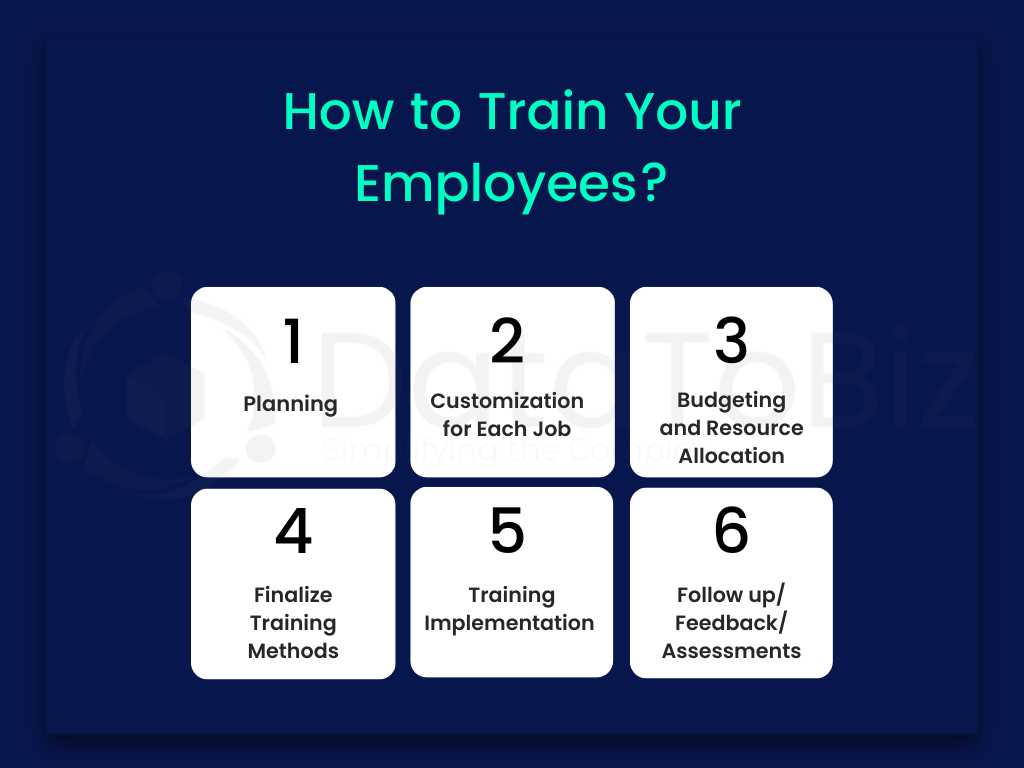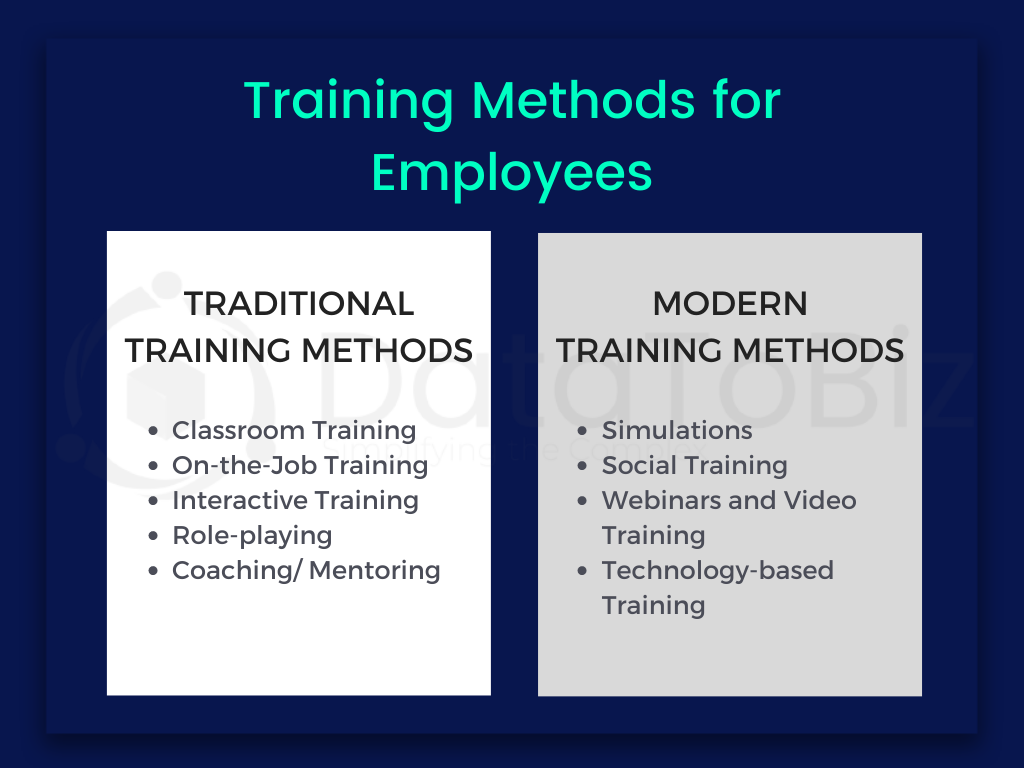Several training methods are popular among business organizations and are implemented across industries. The success of a training method depends on whether it is aligned with the business goals and implemented correctly. We’ll discuss the various aspects related to employee training and popular methods adopted by enterprises.
Hiring a candidate is the first step. Even if you hire someone with years of experience, a training program will be beneficial for the candidate and the organization. It will help the new employee familiarize themself with the internal systems and processes in your business. This makes it easier for them to get used to the work culture and become productive quickly time. This, in turn, reduces the employee turnover rate and increases employee satisfaction.
Employee training is vital to keep your business going and ready to tackle the changing market conditions. Different workplace training techniques are implemented based on the job requirements and business goals. However, creating a training program and implementing it is tricky and filled with challenges.
Enterprises can no longer rely on a single training method. Employees want 360-degree training and programs that continue as long as they are employed with the business. In such instances, how do you use the different employee training methods to empower your workforce? Which training model is the best choice for your organization? How can you determine if the model is delivering the expected results?
Let’s find out more about these questions. Check out the popular methods for training employees and assessments can help analyze the efficiency of the training models.
How to Train Your Employees?
Workplace training is not done randomly. Whether you follow the traditional methods or prefer modern techniques, the process has to be strategized, planned, implemented and assessed to ensure it is effective.

Planning
Create a comprehensive plan to determine the best method for training employees. The plan will continue to change over the years as your business grows. Define the objectives of conducting the training program and list out the goals.
Customization for Each Job
Compile a list of jobs that require specific skills and knowledge. Use the job descriptions to note the key skills expected from the employee. Even though you hire candidates with the necessary skills and expertise, you still need to explain how the skills will be used in your business to complete the job. Customize the training program for each job to get a clear picture of how many types of training programs you need to create.
Budgeting and Resource Allocation
A budget is crucial for any business. Even large enterprises have a budget for training programs. After all, you need to measure the results and get ROI to determine if the investment is worth it. The top management sits with the finance heads to finalize the budget for the training programs. Once done, allocate the necessary resources (money, technology, trainers, rooms, etc.) to start the training programs.
Finalize Training Methods
Which employee training methods are suited to your specifications? Will traditional methods be enough, or will you rely on modern training methods? Do you think a combination of both will be more beneficial? Use historical data to derive analytics and make data-driven decisions to minimize risk.
Training Implementation
Implement the training program once you have everything in place. Select employees who require training the most and conduct the programs as per the pre-defined plan. It is best to keep track of the progress.
Follow-up/ Feedback/ Assessments
After the training program is over, you need to determine if it was successful or not. Get feedback from employees. Conduct tests using assessment generation platforms like PrepAI to measure employees’ retaining and learning capacity. Assessments are a must after employee training.
Reasons to Provide Training for Employees
Why is employee training important, and how can it help your business? Find out below.
- Close to 70% of employees want to learn or join a training program in their workplace.
- Training improves employee satisfaction and increases the retention rate.
- 94% of employees say they will stay with an organization that provides appropriate job-related training.
- A trained and efficient employee will be more productive and innovative at work.
- Around 75% of employees join the training program recommended by their managers.
- Reliable training programs increase your business reputation and bring consistency.
- Employees will be engaged with the business and feel an emotional connection to the job.
- Identifying future leaders is easy when you analyze the data from training programs and employee performance records.
- You have fewer chances of losing your employees to competitors. Good training programs give you a definite edge in the market.
Training Methods for Employees
There are several methods of training employees. Many organizations use a combination of methods and techniques to achieve results.

Traditional Training Methods
Classroom Training
This training method is similar to how schools and colleges conduct classes. The employees have to physically attend the training sessions (on-site or off-site). The training includes presentations, case studies, lectures, etc., followed by assessments. In this method, you can train large batches of employees at once. However, conducting classroom training off-site is expensive and can increase the budget.
On-the-Job Training
This training method is the opposite of the previous one. The employees are trained when working on the projects assigned to them. The process combined learning and completion of work simultaneously. It is considered the best way to train employees as they will learn quickly. Resources will not be wasted on expensive training sessions. However, all employees don’t like on-the-job training. They find it stressful and too fast-paced to keep up.
Interactive Training
In this training method, employees are made an active part of the training session through quizzes, games, etc. Employees learn new skills and put them into practice in the session and at work. This increases retaining capacity and makes them more efficient. However, interactive training is time-consuming. Furthermore, this method works best for small groups, and the trainer can give one-to-one feedback to each employee.
Role-playing
Role-playing is a type of interactive training method where employees are given a scenario and asked to act accordingly. For example, a customer service agent could be asked to convince a customer or explain the terms for invoking a warranty. One employee will be the customer service agent, while another employee/ trainer will be the customer. Other employees attending the session will be asked to share their observations at the end. This is also time-consuming, and some employees may not be comfortable with this training method.
Coaching/ Mentoring
Mentoring is where a senior employee is tasked to coach new employee(s) about work and organization-related aspects. Mentoring programs have a lot of advantages, as new employees can gain insights from their mentors and interact with them directly. However, it puts pressure on the mentors as they have to spend extra time on this apart from fulfilling their daily responsibilities at work.
Modern Training Methods
Simulations
This is another popular training model for employees. It is cost-effective and efficient in transferring the necessary skills to employees. Simulations are a little similar to role-playing conceptually but use technology to create real-life scenarios for employees to react in real time. Theory and practical application are managed simultaneously, though the method changes from one industry/ department to another. For example, simulation training for technicians includes working with machinery.
Social Training
Social training or learning is one of the hardest training methods to implement. Trainees have to observe other employees at work and learn from them through imitation. It is an effective method in some cases, as employees can learn how to handle crisis situations, make complex decisions, and solve problems at work. Employees can acquire new skills if this method is correctly implemented.
Webinars and Video Training
This is also known as online training and takes place virtually. This method of employee training has become common in recent times. It is cost-effective, saves time, and gives employees the chance to attend the sessions from different locations. You can create an online training program with recorded videos and webinars or use a combination of live and recorded sessions.
Technology-based Training
This is another form of online training where an LMS is integrated with the existing business systems. Many organizations are adopting this training method despite the initial setup costs, as it delivers long-term benefits and ROI. Employees have access to the knowledge base even after their training period is complete. In fact, employees are trained almost throughout their stay at the enterprise.
Furthermore, technology-based training makes it easy to conduct assessments, monitor their performance, and keep their records updated in real time. For example, you can integrate assessment generator tools with the LMS to generate question papers, quizzes, etc., in less time and share them with the employees. PrepAI is a well-known questions and answers generation platform that can be integrated with third-party learning management systems and is suitable for a business of all sizes.
Employee Training Models
The training model differs from one enterprise to another. It determines how your training methods will be implemented and can be used to make the necessary changes to the training programs. The following are the three major training models implemented by organizations.
Centralized Training Model
A centralized training model is where all the employees from different branches will travel to the dedicated training location to attend the program. This method ensures consistency as every employee gets the same level of training. The standards are easy to maintain in this method. That said, arranging for employees to travel to the training center can be expensive. Also, the results of the training will vary depending on employees’ individual capabilities. There is no scope for personal training in this model.
Departmental Training Model
This is a slightly decentralized version where the training programs are conducted by department heads and change from one department to another. For example, the sales department training will be conducted within the department and focuses on the core aspects of sales and marketing. This model allows more freedom and lets the trainers provide personal feedback and attention to the trainees. However, the quality of training will not be consistent. Some departments might deliver better than others.
Kirkpatrick Training Model
Kirkpatrick’s training model is a learning evaluation method that determines the efficiency of a training method based on four factors- reaction, learning, behavior, and results. This model can be used at multiple stages of training to get a clear picture of the process and determine its success.
Effective Training Techniques
When developing a training program for employees, you need to determine what works for your business and employees. The results have to be seen in the short and long term in terms of ROI, improved employee performance, high productivity, etc.
- Understand employees, their strengths, and weaknesses before finalizing the training program. One method doesn’t suit everyone.
- Create a plan based on immediate and long-term requirements from the training program.
- Determine the active training approach to make employee-centric and interactive. This can be online, offline, or both.
- Ask questions, encourage discussions, and involve employees in the process. Take their feedback and make the most of diverse opinions.
- Conduct assessments periodically to measure if employees are retaining their newly acquired knowledge and skills.
- Invest in technology by integrating LMS and assessment tools with the business systems. Streamline training across the enterprise.
- Regularly evaluate the training programs and tweak them to get better results and higher ROI.
Conclusion
Employee training has become important for organizations and employees in the last few years. Proper training methods can give your business new opportunities for growth, bridge the talent gap, and retain employees for a longer period. Take the time required to understand different training methods before finalizing the ones that suit your business vision and goals.
Furthermore, give equal importance to assessments and make them an integral part of the training programs. Employee assessments are a tried and tested process to measure the success of your training from an employee performance point of view. Training and assessments together can keep your business ahead of competitors.




